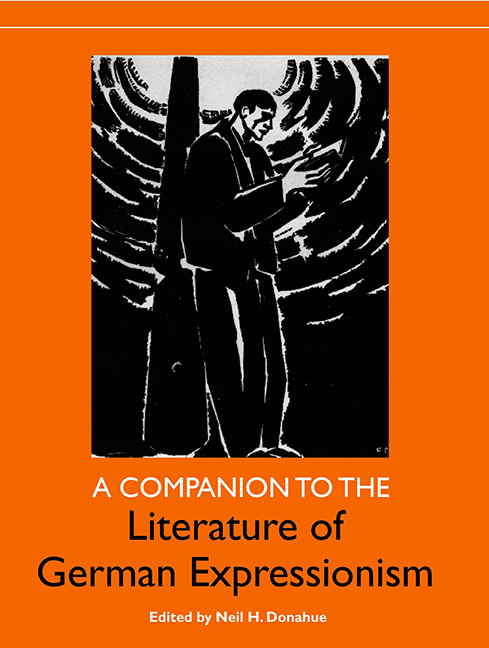Book contents
- Frontmatter
- Contents
- List of Illustrations
- Preface and Acknowledgments
- Chronology
- Introduction
- Philosophical Background
- Prose
- 2 The Prose of German Expressionism
- 3 Prosaic Intensities: The Short Prose of German Expressionism
- 4 The Cutting Edge of German Expressionism: The Woodcut Novel of Frans Masereel and Its Influences
- Poetry
- Drama
- Interdisciplinary
- Select Bibliography
- Notes on the Contributors
- Index
2 - The Prose of German Expressionism
from Prose
Published online by Cambridge University Press: 28 April 2017
- Frontmatter
- Contents
- List of Illustrations
- Preface and Acknowledgments
- Chronology
- Introduction
- Philosophical Background
- Prose
- 2 The Prose of German Expressionism
- 3 Prosaic Intensities: The Short Prose of German Expressionism
- 4 The Cutting Edge of German Expressionism: The Woodcut Novel of Frans Masereel and Its Influences
- Poetry
- Drama
- Interdisciplinary
- Select Bibliography
- Notes on the Contributors
- Index
Summary
In his introduction to the catalog to the Marbach Expressionism exhibit in 1960, Bernhard Zeller observed: “Schon die Frage, welche Dichter, welche Werke als expressionistisch anzusehen sind, ist heute wie ehedem nicht immer ganz eindeutig zu beantworten” (Even the question as to which poets, which works are to be considered Expressionist, now as then cannot always receive a completely definitive answer; 5). Indeed, “not always completely definitive” is an exemplary instance of understatement. The question is not only vague and ambiguous, but exceptionally difficult to answer, because we do not have criteria that would provide us with the necessary information to correctly pose the question. Indeed, there exists a general, albeit somewhat tentative, consensus of scholarly opinion that the works of writers published in avant-garde periodicals between 1910 and the early 1920s may be termed Expressionist. Besides these, we should also include works that appeared in a book series such as “Der jüngste Tag” (The Newest Day, published by Kurt Wolff) and anthologies such as Kurt Pinthus's Menschheitsdämmerung (Dawn of Humanity, 1920). However, these are purely external and accidental criteria, conveying little about the shared formal, stylistic, and thematic characteristics of these writers. Nevertheless, they do provide a point of departure for subsequent study. Perhaps the question can be posed in this way: What are the inherent or formal characteristics shared by the many writers whose works appeared in avant-garde periodicals, book series, and anthologies between 1910 and 1923 or 1925 that would entitle us to call them Expressionist? Would a characterization that would allow a comparison to Romanticism or Naturalism be preferable? Despite the fact that in these much longer and better-researched literary movements terminological ambiguity still persists (indeed, over-generalization is intrinsic to any definition of genre), the terms Romanticism and Naturalism are nevertheless based upon far more concise and accepted criteria than the constant vacillation found in the term Expressionism. In this essay, the question of what criteria would be most suitable to define Expressionism will be addressed, specifically in respect to a single literary genre, namely, narrative prose.
Before we proceed with an analysis of the texts themselves, we must determine whether we can formulate a theory of Expressionism, specifically a poetics of narration that would enable us to devise a coherent theory of Expressionist prose.
- Type
- Chapter
- Information
- A Companion to the Literature of German Expressionism , pp. 69 - 88Publisher: Boydell & BrewerPrint publication year: 2005

